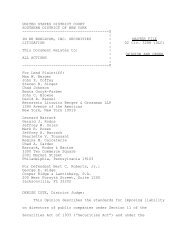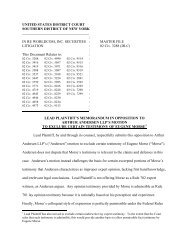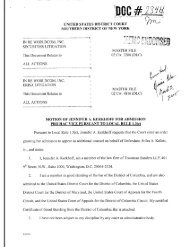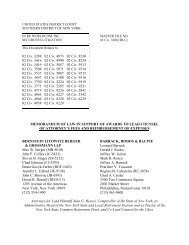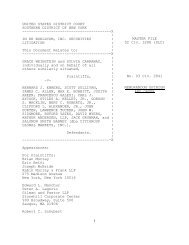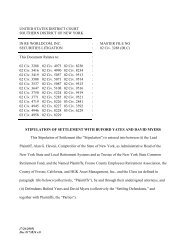Lead Plaintiff's Memorandum of Law in Opposition to Defendants'
Lead Plaintiff's Memorandum of Law in Opposition to Defendants'
Lead Plaintiff's Memorandum of Law in Opposition to Defendants'
Create successful ePaper yourself
Turn your PDF publications into a flip-book with our unique Google optimized e-Paper software.
ecause this Court appo<strong>in</strong>ted a lead pla<strong>in</strong>tiff that did not purchase bonds on the Offer<strong>in</strong>gs.<br />
Unfortunately for the Underwriter Defendants (and the Salomon Defendants, Andersen, and Ebbers,<br />
who adopt this argument as well), this po<strong>in</strong>t rests on a fundamental misapprehension <strong>of</strong> the lead pla<strong>in</strong>tiff<br />
provisions <strong>of</strong> the PSLRA, which was never <strong>in</strong>tended <strong>to</strong> excise from a consolidated class action claims<br />
that the lead pla<strong>in</strong>tiff does not itself possess -- particularly where, as here, the consolidated compla<strong>in</strong>t<br />
specifically identifies named pla<strong>in</strong>tiffs who do have those claims (Po<strong>in</strong>t I.B.). As the Underwriter<br />
Defendants are constra<strong>in</strong>ed <strong>to</strong> concede, the very argument they make here was emphatically rejected <strong>in</strong><br />
this District just a few weeks ago, when Judge Sche<strong>in</strong>dl<strong>in</strong> issued her rul<strong>in</strong>g on the motions <strong>to</strong> dismiss <strong>in</strong><br />
In re Initial Pub. Offer<strong>in</strong>gs Sec. Litig., No. 21 MC 92, 2002 U.S. Dist. LEXIS 23823 (S.D.N.Y. Dec.<br />
12, 2002) (hereafter, “IPO Sec. Litig.”). After review<strong>in</strong>g the his<strong>to</strong>ry and construction <strong>of</strong> the pert<strong>in</strong>ent<br />
PSLRA provisions, Judge Sche<strong>in</strong>dl<strong>in</strong> observed,<br />
The fact that the lead pla<strong>in</strong>tiff is <strong>to</strong> be selected <strong>in</strong> accordance with objective criteria that<br />
have noth<strong>in</strong>g <strong>to</strong> do with the nature <strong>of</strong> the claims . . . strongly suggests the need for<br />
named pla<strong>in</strong>tiffs <strong>in</strong> addition <strong>to</strong> any lead pla<strong>in</strong>tiff. Courts are constra<strong>in</strong>ed <strong>to</strong> choose a<br />
lead pla<strong>in</strong>tiff who has, among other th<strong>in</strong>gs, the largest f<strong>in</strong>ancial stake <strong>in</strong> the outcome <strong>of</strong><br />
the case. It stands <strong>to</strong> reason that <strong>in</strong> many cases, the <strong>in</strong>stant cases <strong>in</strong>cluded, the pla<strong>in</strong>tiff<br />
with the largest f<strong>in</strong>ancial <strong>in</strong>terest may not have stand<strong>in</strong>g <strong>to</strong> sue on all causes <strong>of</strong> action.<br />
There is noth<strong>in</strong>g <strong>to</strong> suggest that, <strong>in</strong> those cases, Congress <strong>in</strong>tended that pla<strong>in</strong>tiffs must<br />
file an entirely separate class action lawsuit when, <strong>in</strong> any other context, a subclass<br />
would suffice.<br />
Id. at *14 (cit<strong>in</strong>g Newby v. Enron Corp. (In re Enron Corp., Securities Litigation), 206 F.R.D. 427,<br />
451 (S.D. Tex. 2002) (hereafter, “Enron Sec. Litig.”).<br />
The stand<strong>in</strong>g arguments pr<strong>of</strong>fered by the Underwriter Defendants aga<strong>in</strong>st the pla<strong>in</strong>tiffs who did<br />
purchase bonds <strong>in</strong> the Offer<strong>in</strong>gs are also ill-founded. As expla<strong>in</strong>ed below (Po<strong>in</strong>t I.C.), the County <strong>of</strong><br />
Fresno (“Fresno”), the Fresno County Employees Retirement Association (“FCERA”), and HGK<br />
-4-



